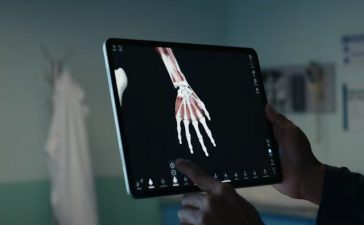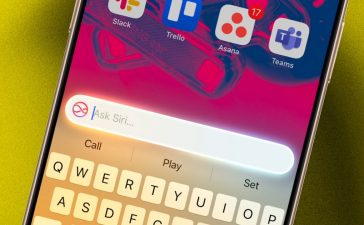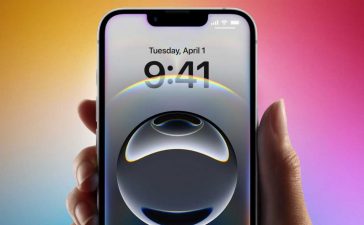Apple last month released the first beta version of the software that powers its upcoming Apple Vision Pro headset, visionOS, plus the visionOS software development kit and a simulator.
We’re already seeing pictures and videos of Vision Pro apps online long before the $3,499 spacial computing device ships. (The device is expected to ship in the first half of 2024.)
Apple also announced plans to roll out “developer labs” — where software makers can try out their creations on actual Vision Pro hardware and get help from Apple engineers. These labs will open later this month in Cupertino, London, Munich, Shanghai, Singapore and Tokyo, according to Apple.
All these releases, announcements and developer activity are starting to clarify how vision OS will be used by businesses and enterprises.
Why apps will control the future of spacial computing
When Apple shipped its first iPhone in the summer of 2007, I didn’t buy one. I was still enamored with my tiny “Blackberry Pearl” phone. I thought the first iPhone (tiny by today’s smartphone standards) was too big.
A year later, Apple unveiled its App Store. That addition (plus Google’s Android Play Store) changed everything — for me, and the world.
When the original iPhone shipped, it was impossible to predict how people would come to use smartphones — think about the ubiquity of social networking and the world of Instagram and TikTok influencers; video zoom calls from the car; the rise of audio and video podcasting as a major medium; the use of Google Maps to provide turn-by-turn directions for hundreds of millions of drives; QR-code restaurant menus; thousands of sophisticated games in your pocket; the arrival of voice-based personal assistants like Siri; the ability to scan any bottle of wine and get detailed information about it instantly and (after drinking said bottle of wine) the ability to summon a ride; door-step food ordering from hundreds of restaurants; and thousands of other changes in how people live every day.
Smartphones had an equally major impact in the world of business, but it wasn’t the smartphones themselves that did all this. It was the smartphone apps that changed how people live and work.
We couldn’t predict in 2007 how smartphones would change the world. And we can’t predict now how augmented reality will change the world in the years ahead.
All that started to change last week. With developers starting to make the apps, we can glimpse how our world might change.
The emergence of visionOS apps and demos will teach us new experiences for working, including words, phrases and concepts like “Volumes (3D content within defined boundaries),” “Shared Space” (showing more than one app floating in space), and “Full Space” where one app takes over the whole visual environment, displays disconnected 3D content that moves around in the room, portals to virtual worlds or full-blown VR.
Developers revealed that visionOS enables users to place controls or displays on any surface, such as tables and walls. An app, for example, can be pasted like a poster on a wall. Timers can hover over the activity being timed. Volume sliders can lay flat on a table. Your real desk can get a virtual and fully functional keyboard.
And a “travel mode” shows how Apple is working to make Vision Pro airplane-friendly, which could transform what kind of work and communication is possible during business trips. During “travel mode,” Apple will warn users that “some awareness features will be off.” Presumably that means your virtual eyes (a feature called EyeSight) won’t show on the external display and freak out flight attendants and the proximity of other passengers won’t automatically show up in your field of view — the visual equivalent of a noise-cancellation feature in headphones.
Apple’s WWDC demo showed FaceTime calls to replace Zoom calls, with other callers floating in space inside rectangular windows. In closed developer sessions, Apple demonstrated the future of this interface, with the callers floating in space without the rectangles. (This is the Bionic Meeting Room technology I’ve been harping about for the last few years.)
The Vision Pro also has a “Guest Mode,” enabling a user who is not registered to a particular device to use it temporarily.
Possible trouble in virtual paradise
Apps could make the visionOS platform — or they could break it. Hidden in the developer materials, you could find some anxiety on the part of Apple about physical reactions to AR. Apple’s guidelines urge developers to avoid design decisions that can lead to motion sickness, pay attention to “visual comfort” and avoid “excessive” or “overwhelming” movements, according to developer Steve Moser. Indeed, some early testers of the Vision Pro claim minor nausea while using the device, as well as some discomfort from the weight of the headset. (Reports suggest a mitigating strap or two may be included free or sold as optional accessories.)
Another area of concern: Apple’s decision to use photo-realistic scanned faces as animated, real-time avatars for FaceTime video calls (they’re called Personas). Even Apple’s carefully crafted versions in demos creeped people out a bit. Apple should use more cartoon-like avatars and, if they don’t, no doubt app developers will.
(Reports suggest that at first FaceTime Personas will be limited to one-to-one calls, with multiple-caller Personas coming in later versions.)
How to tell Apple is serious about Vision Pro for computing
In addition to third-party apps, Vision Pro will come with Apple apps. The visionOS beta contains more than 20 built-in apps, including macOS and iOS standards like Find My, Contacts, Files, Freeform, Home, iCloud, iTunes, Messages, Maps, Calendar, Safari, Apple News, Wallet, Photos, Settings, Shortcuts, Health and Reminders, as well as visionOS-specific offerings that include Animoji Stickers, Family app, EventView, Find My Remote, Game Center, Login, Preferences, Print Center, Quick Look, SideCar, TestFlight and Sleep Widget.
And, of course, Siri should be central to the Vision Pro user interface. The US Patent & Trademark Office published an Apple patent application that includes new Siri commands for controlling applications, including business apps, on Vision Pro (and other platforms).
Tech prognosticator Ming-Chi Kuo predicted that the second Vision Pro rollout should happen in 2025. The next version would come in two higher and two lower versions — one line cheaper, both in user experience and price, and the other line higher end than the first version.
I noted last month Apple’s embrace of the AR PC concept, where an AR device gives you a desktop or laptop screen, apps and all. Apple demonstrated this feature at WWDC showing one desktop screen. Bloomberg’s Mark Gurman says the next version will enable multiple Mac desktop screens.
Another innovation implied in the announcement but not explicitly advertised is the fact that Vision Pro’s camera can take 3D photographs. While consumers are unlikely to embrace 3D photography (if the public reaction to 3D TV is a reliable predictor), there’s no telling what practical uses businesses will make of this capability.
Why Apple Vision Pro means business
Some day, it’s likely that Apple’s spacial computing products will change how consumers live, communicate and play. But in the short term, it’s really businesses and enterprises that will change from this new product line.
Needless to say, the ability for highly portable hardware to display several huge, high-resolution screens transforms who can work remotely and how. Starting next year, we’re likely to see business calls and meetings go virtual through Apple Vision Pro and similar devices.
Marketers will surely embrace augmented reality for experiential marketing events, for in-home and at-work marketing and, of course, the ad industry will figure out how to sell ad space in virtual spaces.
Designers will go nuts when the design apps inevitably drop. Creating 3D models in the middle of the room, and tweaking them with hand gestures will be game changing for them. Training simulations will get a huge boost in enterprises from the Vision Pro, too. The same goes for maintenance, repair and remote support. Workers will be able to conjure up detailed information in both factory and field, hands-free.
AT&T’s networking head, Jeremy Legg, predicted recently that Apple would add 5G connectivity to Vision Pro, making it a mobile device beyond WiFi — expressing a widely held view in the telecom world. Such an addition would enable enormous numbers of new enterprise uses, such as field work, fleet management and more flexible experiential marketing applications.
Simply by announcing Vision Pro, Apple is already changing the market. Google, for example, has reportedly canceled its Iris AR/VR product plans because (according to rumor) Apple’s product is just too good to compete with. That product was positioned in the press as a successor to Google Glass Enterprise Edition, which itself was recently canceled.
Meanwhile, other AR/VR glasses makers are getting a boost because Apple is making the market believe in the future of spacial computing.
But when the hardware gets real next year, and the software starts to emerge, that’s when the real change begins.
Copyright © 2023 IDG Communications, Inc.












